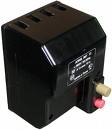Circuit breaker testing
Circuit breakers are used to protect AC distribution networks and electrical receivers in insulation failure emergency situations. To perform protective functions, circuit breakers have overcurrent and short circuit. When the currents pass through the circuit breaker more than the rated currents, it must trip. Overload protection is provided by thermal or electronic devices. Protection against short-circuit currents is provided by electromagnetic or electronic releases.
The measured value is the tripping time of the circuit breaker at a given current value exceeding the rated current of the circuit breaker.
The time current characteristic (trip characteristic) of the breaker is checked in accordance with the requirements of GOST R 50345-99 in accordance with table 1.
Table 1. Standard time-current characteristics of circuit breakers
Trial Period Type of Breaker Instantaneous Release Test Current Initial Condition Making or Non-Tripping Times Desired Result a B, C, D 1.13 in. Cold (no pre-current) t> 1 h (at In> 63 A) t> 2 h (at In <63 A) No separation b B, C, D 1.45 in Immediately after point a t <1 h (at In> 63 A) t 63 A) Separation ° C B, C, D 2.55 in Cold 1 s <t <60 s (at In ≥ 32 A) 1 s <t <120 s (at In ≥ 32 A) Separation d B 3.00 in Cold t> 0.1 s Separation ° C 5.00 in d 10.00 in d B 5 in Cold t <0 ,1 s Separation ° C 10 in. d 50 in
During the tests, the following conditions were met:
— the circuit breaker is installed vertically;
— the tested breaker is disconnected from the network;
— circuit breaker tests are carried out at mains frequency (50 ± 5) Hz;
 Conduct circuit breaker tripping tests
Conduct circuit breaker tripping tests
Assemble a circuit breaker trip test circuit according to the manufacturer's instructions for the load device being used. The electromagnetic release switches off without a time delay. The combined release must trip with a reverse time delay in case of overload and no time delay in case of short circuit. The setting current of the releases is not regulated.
Each pole of the machine has its own thermal element which acts on the general release of the machine. To ensure the correct operation of all thermal elements, it is necessary to check each of them separately.
When testing a large number of machines simultaneously, testing heating elements by initial inrush current is impractical, as it takes several hours to check each machine.In this regard, it is recommended to check heating elements with a test current equal to two and three times the rated current of the release with a simultaneous load with the test current on all poles of the circuit breakers.
If the thermal element does not work, then the machine is not suitable for operation and is not subject to further tests.
All thermal elements should be checked for thermal performance by simultaneously charging all poles of the machine with test current. For this, all poles of the machine are connected in series. When checking electromagnetic releases that do not have thermal elements, the machine is turned on manually and the test current is set to such a value that the machine will turn off. After turning off the machine, the current is reduced to zero and the electromagnetic elements in the remaining poles of the machine are checked in the specified order.
The response time of the machine is determined by the stopwatch scale of the test equipment. The current-time characteristics of the circuit-breaker release interruption must be in accordance with the manufacturer's calibration and passport data. Checking the operation of electromagnetic and thermal releases of circuit breakers in the amount of 30%, of which 15% are apartments farthest from the ASU. If 10% of the tested breakers fail, all 100% of the breakers are checked for tripping.
 Control of the accuracy of measurement results when testing circuit breakers
Control of the accuracy of measurement results when testing circuit breakers
The control of the accuracy of the measurement results is provided by the annual inspection of the instruments used for testing circuit breakers in the bodies of the State Standard of the Russian Federation.Devices must have valid health certificates. It is not allowed to perform measurements with a device with an overdue verification period.
Recording of circuit breaker test results
The results of the tests are documented in the protocol «Testing of circuit breakers with voltage up to 1000V».
Requirements for the qualification of personnel in the testing of circuit breakers
Only persons who have undergone special training and certification with a task can take measurements. electrical safety groups not lower than III when working in electrical installations up to 1000 V, with a record of admission to tests and measurements in electrical installations up to 1000 V.
The operation of the circuit breaker is checked on order only by qualified personnel in a team of at least 2 people. Artist must have 5th grade, team members must have at least 4th grade.
Ensuring safety when testing circuit breakers
When checking the operability of circuit breakers, it is necessary to be guided by the requirements of the Inter-industrial rules for labor protection (safety rules) during the operation of electrical installations.
Circuit breaker tests can only be performed with the electrical installation disconnected. The tests must be carried out by order of a team of at least 2 people. Connection and disconnection of the test set, load ends must be done with the test voltage removed.
